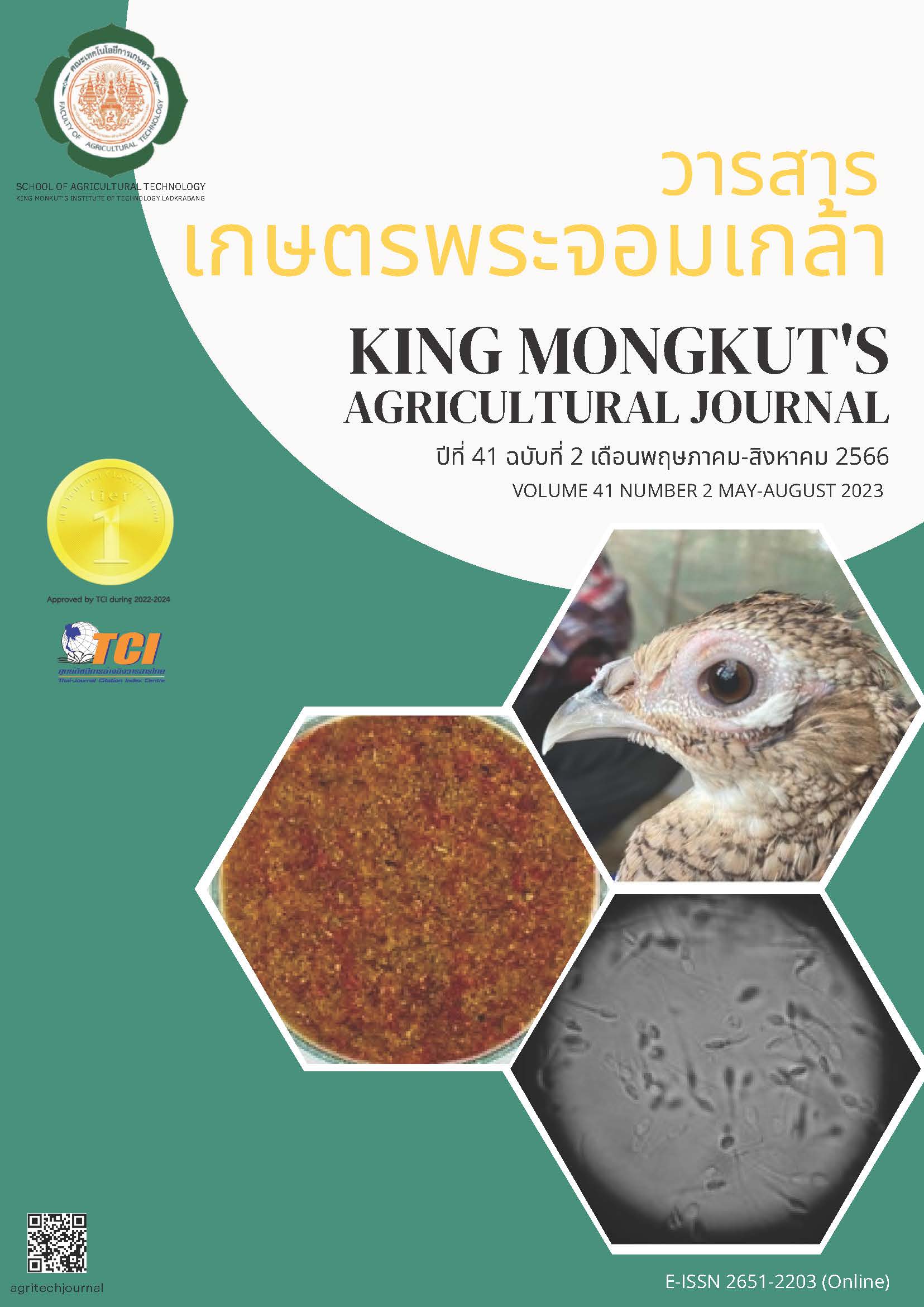ประสิทธิภาพของน้ำมันหอมระเหยจากขิงและตะไคร้หอมในการกำจัดหมัดไก่
Main Article Content
บทคัดย่อ
ประสิทธิภาพของน้ำมันหอมระเหยจากตะไคร้หอม (Cymbopogon nardus Rendle.) และขิง (Zingiber officinale Roscoe) ต่อการกำจัดหมัดไก่ (Echidnophaga gallinacean) ในไก่ฟ้าคอแหวน (Phasianus colchicus) แบ่งเป็น 4 กลุ่ม ได้แก่ กลุ่มที่ใช้น้ำมันหอมระเหยขิง 4%, น้ำมันหอมระเหยตะไคร้หอม 4%, สารกำจัดแมลงทางการค้า (Trichlorfon®) 0.15% และ กลุ่มควบคุมลบ (น้ำยาสำหรับเจือจางน้ำมันหอมระเหย) ให้สารด้วยวิธีการสเปรย์บริเวณที่มีหมัดปริมาณ 1 มิลลิลิตรต่อน้ำหนักตัว 1 กิโลกรัม และวัดผลการทดลองโดยการนับจำนวนหมัดก่อนสเปรย์, ภายหลังจากสเปรย์ 1, 7 และ 14 วัน ส่วนประสิทธิภาพในการกำจัดหมัดไก่พบว่า ภายหลังการสเปรย์ 1 วัน กลุ่มที่สเปรย์ด้วย Trichlorfon® มีอัตราการพบหมัดไก่น้อยกว่ากลุ่มอื่นอย่างมีนัยสำคัญทางสถิติยิ่ง (p<0.001) ในขณะที่กลุ่มที่สเปรย์น้ำมันหอมระเหยทั้งสองชนิดและกลุ่มควบคุมลบไม่แตกต่างกันอย่างมีนัยสำคัญทางสถิติ ส่วนวันที่ 7 และ 14 พบว่ากลุ่มที่สเปรย์ด้วย Trichlorfon® ไม่พบหมัดไก่เลย กลุ่มที่สเปรย์น้ำมันหอมระเหยตะไคร้หอมและขิงพบหมัดไก่ลดลงในวันที่ 7 และลดมากที่สุดในวันที่ 14 ซึ่งแตกต่างอย่างมีนัยสำคัญทางสถิติยิ่งกับกลุ่มควบคุมลบ (p<0.001) โดยน้ำมันตะไคร้หอมสามารถลดหมัดไก่ได้มากกว่าน้ำมันหอมระเหยขิงอย่างมีนัยสำคัญทางสถิติ (p<0.05) และไม่แตกต่างกับกลุ่ม Trichlorfon® สรุปผลการศึกษาพบว่าน้ำมันหอมระเหยตะไคร้หอมและขิงเป็นสมุนไพรทางเลือกหนึ่งที่สามารถนำมาใช้ในการกำจัดพยาธิภายนอกได้ แม้จะใช้เวลานานกว่าสารฆ่าแมลงทางการค้า แต่ก็มีฤทธิ์ตกค้างในสิ่งแวดล้อมน้อย ไม่ส่งผลเสียต่อผู้บริโภคและยังสามารถประยุกต์ใช้ในการผลิตสัตว์ในระบบอินทรีย์ได้
Article Details

อนุญาตภายใต้เงื่อนไข Creative Commons Attribution-NonCommercial-NoDerivatives 4.0 International License.
วารสารเกษตรพระจอมเกล้า
เอกสารอ้างอิง
Rattanasetthakun, C. (1986). Poultry disease. KhonKaen: KhonKaen University. (in Thai).
Chungsamarnyart, N. & Jansawan, W. (1996). Acaricidal activity of the combine of plant crude extracts to tropical cattle tick. In The 34th Kasetsart University Annual Conference. Bangkok: Kasetsart University. (in Thai).
Nopwinyoowong, S. & Sukolapong, V. (1994). Parasite in poultry. KU Veterinary Journal. 4, 42-48. (in Thai).
Buranarak, P. (1997). Removal and prevention of all forms of blackness flea. SanKai Journal. 45(10), 17-18. (in Thai).
Klymuk, K., Kerdchoechuen, O., Laohakunjit, N. & Tripetch, P. (2007). Identification of Limonoid Extracts from Mandarin Seeds Infected with Fungi. Agricultural Science Journal. 38(6) (Suppl.), 58-61. (in Thai).
Prasom, W. & Doungsuwan, S. (2016). Acaricidal effect of essential oils against Dermanyssus gallinae. A special problem submitted in partal fulfillment of the requirements for the degree of Doctor of Pharmacy faculty of pharmacy, Chiangmai University. (in Thai).
Hati, S.S., Dimari G.A., Egwu G.O. & Ogugbuaja V.O. (2010). Specific gravity and antibacterial assays of some synthetic industrial essential oils. The Scientific World Journal. 5(1), 11-15.
Lim, K., Hanifah, Y., Yusof, M. & Thong, K. L. (2012). ermA, ermC, tetM and tetK are essential for erythromycin and tetracycline resistance among methicillin-resistant Staphylococcus aureus strains isolated from a tertiary hospital in Malaysia. Indian journal of medical microbiology. 30(2), 203.
Kim, E. H., Yi, J. H., Tak, J. H. & Ahn, Y. J. (2004). Acaricidal activity of plant essential oils against Dermanyssus gallinae (Acari: Dermanyssidae). Veterinary Parasitology. 120, 297-304.
Madreseh-Ghahfarokhi, S., Dehghani-Samani, A., Pirali, Y. & Dehghani-Samani, A. (2019). Zingiber officinalis and Eucalyptus globulus, potent lethal/repellent agents against Rhipicephalus bursa, probable carrier for zoonosis. Journal of Arthropod-Borne Diseases. 13(2), 214.
Mieso, B. & Befa, A. (2020). Physical Characteristics of the essential oil extracted from released and improved spearmint varieties, peppermint, and Japanese mint. Journal of Applied Research on Medicinal and Aromatic Plants. 9(355), 1-4.
Nerio, L. S., Olivero-Verbel, J. & Stashenko, E. (2010). Repellent activity of essential oils: a review. Bioresource technology. 101(1), 372-378.
Pushpanathan, T., Jebanesan, A. & Govindarajan, M. (2008). The essential oil of Zingiber officinalis Linn (Zingiberaceae) as a mosquito larvicidal and repellent agent against the filarial vector Culex quinquefasciatus Say (Diptera: Culicidae). Parasitology research. 102(6), 1289-1291.
Vigad, N., Pelyuntha, W., Tarachai, P., Chansakaow, S. & Chukiatsiri, K. (2021). Physical Characteristics, Chemical Compositions, and Insecticidal Activity of Plant Essential Oils against Chicken Lice (Menopon Gallinae) and Mites (Ornithonyssus Bursa). Veterinary Integrative Sciences. 19(3), 449-466.


